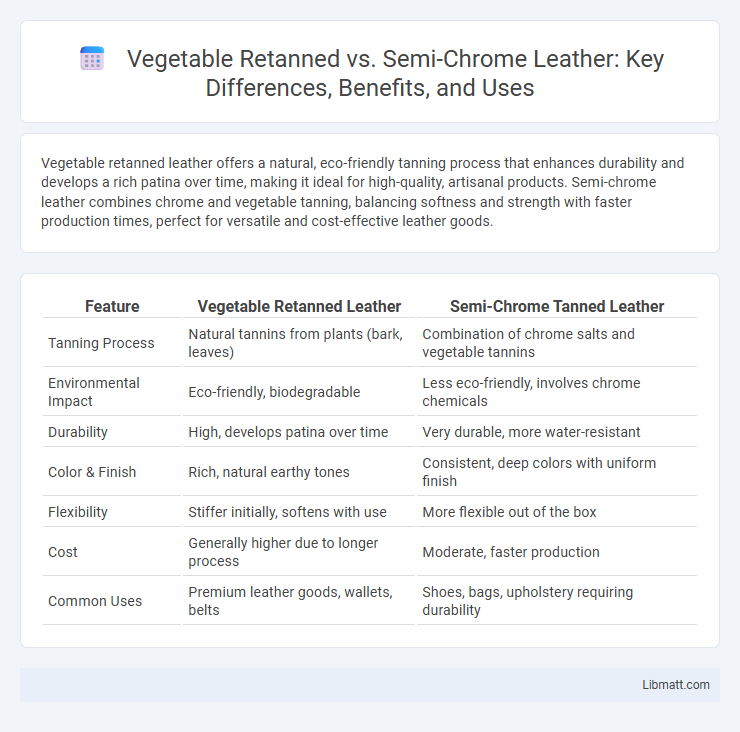Vegetable retanned leather offers a natural, eco-friendly tanning process that enhances durability and develops a rich patina over time, making it ideal for high-quality, artisanal products. Semi-chrome leather combines chrome and vegetable tanning, balancing softness and strength with faster production times, perfect for versatile and cost-effective leather goods.
Table of Comparison
| Feature | Vegetable Retanned Leather | Semi-Chrome Tanned Leather |
|---|---|---|
| Tanning Process | Natural tannins from plants (bark, leaves) | Combination of chrome salts and vegetable tannins |
| Environmental Impact | Eco-friendly, biodegradable | Less eco-friendly, involves chrome chemicals |
| Durability | High, develops patina over time | Very durable, more water-resistant |
| Color & Finish | Rich, natural earthy tones | Consistent, deep colors with uniform finish |
| Flexibility | Stiffer initially, softens with use | More flexible out of the box |
| Cost | Generally higher due to longer process | Moderate, faster production |
| Common Uses | Premium leather goods, wallets, belts | Shoes, bags, upholstery requiring durability |
Introduction to Vegetable Retanned and Semi-Chrome Leather
Vegetable retanned leather undergoes a tanning process using natural tannins from tree bark, yielding a firm, durable material prized for its rich patina and environmental sustainability. Semi-chrome leather combines chrome tanning with vegetable tanning, balancing softness and durability while enhancing resistance to wear and water. Both types serve distinct functions in industries such as upholstery, footwear, and leather goods, catering to varying aesthetic and performance needs.
Defining Vegetable Retanned Leather
Vegetable retanned leather is crafted using natural tannins derived from tree bark, leaves, and fruits, resulting in a durable, eco-friendly material with a rich, earthy aroma and a firm texture. This tanning process enhances leather's breathability and allows it to develop a unique patina over time, making it ideal for high-quality leather goods such as belts, wallets, and saddlery. Compared to semi-chrome tanning, vegetable retanning avoids heavy metal salts, offering a more sustainable option without compromising durability or aesthetic appeal.
Understanding Semi-Chrome Leather
Semi-chrome leather combines chrome tanning with vegetable tanning, offering a balance between durability and natural appearance. This leather type retains some environmental benefits of vegetable tanning while gaining enhanced water resistance and softness from chrome processing. Understanding semi-chrome leather helps you choose materials that meet both aesthetic and functional requirements.
Tanning Processes: Key Differences
Vegetable retanned leather undergoes a natural tanning process using tannins extracted from tree bark and plant materials, resulting in a firm, aromatic, and environmentally friendly hide. Semi-chrome leather combines chrome tanning with a light vegetable retanning phase, offering enhanced softness, improved water resistance, and quicker processing times than pure vegetable tanning. The key differences lie in the chemical agents used and the resulting texture, durability, and eco-impact of each tanning method.
Environmental Impact Comparison
Vegetable retanned leather uses natural tannins extracted from plants, significantly reducing chemical waste and water pollution compared to semi-chrome tanning, which relies on chromium salts and heavy metals that pose environmental hazards. Your choice of vegetable retanned leather supports sustainable practices by minimizing toxic runoff and promoting biodegradability, whereas semi-chrome processes contribute to long-term soil and water contamination. Opting for vegetable retanned materials aligns with eco-friendly manufacturing and reduces the carbon footprint associated with leather production.
Durability and Performance
Vegetable retanned leather offers superior durability due to its natural tanning process, which enhances breathability and ages gracefully, developing a rich patina over time. Semi-chrome tanned leather combines chrome and vegetable tanning methods, delivering increased water resistance and flexibility, making it more suitable for products requiring both toughness and softness. In terms of performance, vegetable retanned leather excels in longevity and environmental friendliness, while semi-chrome leather provides a balance of durability and efficient production suited for a wide range of commercial uses.
Aesthetics and Aging Process
Vegetable retanned leather offers a rich, natural patina that deepens in color and texture over time, showcasing unique marks and character through its slow aging process. Semi-chrome tanned leather provides a more uniform and consistent appearance with moderate aging, exhibiting less variation and a smoother surface durability. Your choice depends on whether you prefer the evolving beauty of vegetable retanning or the stable look of semi-chrome finish.
Cost Effectiveness and Market Value
Vegetable retanned leather offers higher cost-effectiveness due to lower processing expenses and eco-friendly appeal, making it attractive in niche markets that value sustainability. Semi-chrome tanned leather, while generally more expensive to produce, delivers consistent quality and durability, commanding greater market value in commercial applications. Manufacturers balance these factors by selecting vegetable retanning for artisanal products and semi-chrome tanning for mass-produced leather goods.
Applications and Best Uses
Vegetable retanned leather offers excellent durability and develops a rich patina over time, making it ideal for high-quality leather goods, saddlery, and artisan crafts emphasizing natural finishes. Semi-chrome tanned leather provides a balance between toughness and flexibility, suited for footwear, upholstery, and fashion accessories requiring consistent color and moderate water resistance. Choosing between vegetable retanned and semi-chrome depends on the desired aesthetic, functional durability, and manufacturing process for specific applications.
Choosing the Right Leather for Your Needs
Vegetable retanned leather offers a natural, eco-friendly tanning process that produces firm, durable hides with rich, developable patinas, ideal for artisanal crafts and long-lasting products. Semi-chrome leather combines chrome and vegetable tanning techniques, balancing softness and durability, making it suitable for versatile everyday items requiring moderate water resistance and flexibility. Assess your project's durability, aesthetic preferences, and environmental impact to choose the leather that best matches your functional and style requirements.
Vegetable retanned vs semi-chrome Infographic

 libmatt.com
libmatt.com